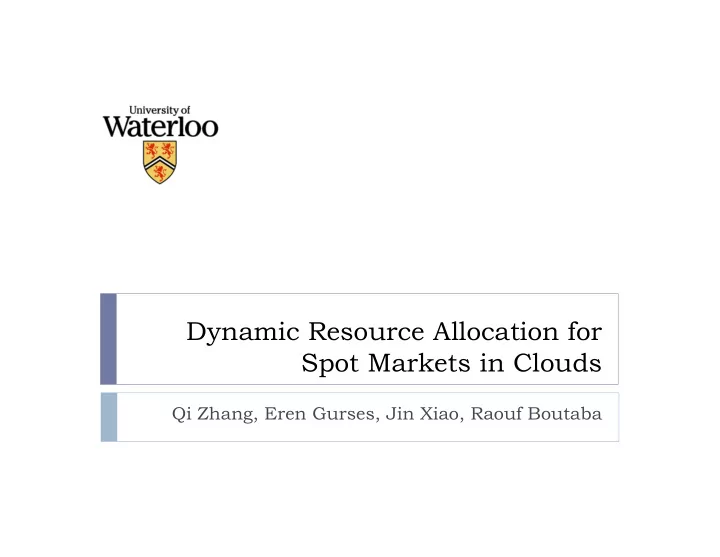

Dynamic Resource Allocation for Spot Markets in Clouds Qi Zhang, Eren Gurses, Jin Xiao, Raouf Boutaba
Introduction Cloud computing aims at providing resources to customers in an on-demand manner A customer can purchase resources dynamically based on the current needs Typically, cloud providers employ usage-based pricing A fixed unit price is specified for each type of VM offerings However, fixed pricing schemes lack incentives to encourage desirable customer behavior Low demand results in poor resource utilization high demand leads to revenue loss and customer dissatisfaction Market-based resource allocation is gaining popularity Let the price fluctuates with supply and demand Dynamic Resource Allocation for Spot Markets in Clouds
Amazon EC2 Spot Instance Service Launched on Dec. 15, 2009 Multiple VM types per availability zone Customers submit requests with bidding prices Spot price fluctuates with supply and demand Instances may be terminated Price of a single m1.small linux instance in with prior notice US-East-1 between Mar. 14- Mar. 20, 2011 Dynamic Resource Allocation for Spot Markets in Clouds
Motivation Multiple spot markets sharing the same resource pool As request arrival can be highly volatile, sometimes certain markets may be “hotter” than others A static allocation strategy can lead to situations where markets are over-supplied or under-supplied Over-supplying a market causes poor resource utilization Under-supplying a market leads to low income and customer dissatisfaction How to dynamically allocate resources to spot markets? Dynamic Resource Allocation for Spot Markets in Clouds
Contribution We propose a framework that dynamically adjust supply of spot markets to maximize total revenue Challenges Need to predict future demand for every spot market Need to determine the allocation strategy that optimizes revenue Our solution Predicting future demand using an autoregressive (AR) model Compute expected spot price and allocation for each market to maximize total revenue Schedule VMs according to expected price Dynamic Resource Allocation for Spot Markets in Clouds
System Architecture Market Analyzer Capacity Planner VM Scheduler Type 1 Type 1 Type 3 Type 1 Type 2 Type 3 Type 1 Type 3 Type 3 Type 3 Dynamic Resource Allocation for Spot Markets in Clouds
Demand Prediction Quantity Quantity Q 1 q 3 Q 2 q 2 Q 3 q 1 P 1 P 2 P 3 t time Price t+T Demand curve Predicting future demand curve Demand curve can be modeled as a non-increasing, piecewise- linear function Predicting future demand curve using autoregressive (AR) functions Dynamic Resource Allocation for Spot Markets in Clouds
Computing Expected Allocation Goal: determine the expected price and allocation of resources to spot markets to maximize total revenue Simple case: Prices are fixed This problem is a variant of the NP-hard multiple knapsack problem (MKP) Real case: Prices are not fixed Much harder than MKP, as objective function is non-linear By approximating the revenue using a concave function, the problem can be reduced to a MKP Dynamic Resource Allocation for Spot Markets in Clouds
Scheduling Algorithm Requests to Type 2 Type 3 be scheduled Type 1 Scheduler Type 1 Type 3 Type 3 Type 1 Type 2 Type 1 Type 3 Type 1 Type 1 Type 3 Type 3 Type 1 Dynamic Resource Allocation for Spot Markets in Clouds
Experiment Setup Implemented the scheduler using CloudSim Modified default resource allocation policies Workload Non-homogenous poisson process with artificial high and low arrival periods Bidding price and running time are generated from normal distributions Scheduling policies Static allocation for each individual market Our dynamic allocation scheme Dynamic Resource Allocation for Spot Markets in Clouds
Experiments Dynamic Resource Allocation for Spot Markets in Clouds
Conclusion Market-based resource allocation mechanisms provide economic incentives to encourage desirable customer behavior We have presented a framework that dynamically adjust supply for different spot markets, with the goal of maximizing total revenue Practical and applicable for any market-based cloud environment that uses uniform price scheme Dynamic Resource Allocation for Spot Markets in Clouds
Thanks! Questions? Dynamic Resource Allocation for Spot Markets in Clouds
Recommend
More recommend